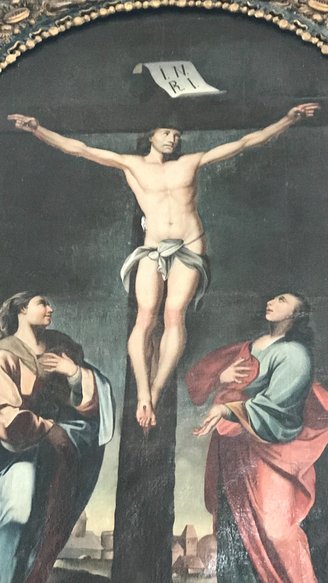A
fly crawls over the still flesh.
Of
what use is it to me that this man has suffered, If I am suffering
now?
— Jorge Luis Borges
###
Swallows flutter in the rafters overhead while Jesus hangs in agony on the wall ten feet in front of me. This little pink church had been beckoning us from below for hours as we hiked the dry hills north of Zacatecas, Mexico. Now, in this child-size pew, I’m quietly absorbing graphic images of the True Faith. Just as kids from the nearby village would do every Sunday.
It’s been a long time since I’ve seen such a bloody Jesus-on-the-cross. I’m used to sanitized images portraying the crucifixion, to the point of His not looking too upset, awaiting His end with that resigned “Yeah, it’s tough job, but someone’s got to do it” expression.
This Jesus pulls no punches. He is in unspeakable pain, His face racked in torment, His body wrenched and contorted. Blood from the five wounds is everywhere, running in streams down His face, over His torso, down His legs. Nail holes gush blood, and the spear has left a gaping bloody hole in His side. Nothing is left to the imagination. Anyone can simply die for your sins, the artist is telling us, but this Jesus suffered for them, nine hours in the process according to young Mark. Plenty of time to ask what in God’s name He was doing there after schlepping that cross up the hill.
While agonized bleeding Jesuses (Jesi?) are the norm in Mexico, in my experience they’re not universal in Roman Catholic churches worldwide. In Europe, life-size statues of our Savior on the Cross are usually expurgated, even to the point of not showing any blood at all. Transylvania, Romania, where we’ve spent the last couple of months, takes a middle ground: a little blood, but no facial agony.

Bloodless Jesus, Cistercian abbey church, Cârța, Sibiu county, Romania (Barry Evans)
You notice this when you’re sitting quietly in Catholic churches. Louisa and I rarely pass a church — of any denomination — without spending time inside, taking in the history of the place, striving to feel the presence of thousands upon thousands of worshippers who have preceded us in this special place — special not because it’s holy, whatever that means (for me, either everything is holy or nothing is), but because the inside of a place of worship is just different from the outside world: quieter, cooler, darker, gentler.
Back to Jesus-as-Savior. “Christ died for your sins” I’ve been told, starting with an evangelist pastor over 60 years ago. Even then I recall thinking, “I wish He’d checked with me first, I could have saved Him the bother.” Not that I was trying to be contrary, just that it never made sense to me, the whole mess about God creating a Son for the sole purpose of getting Him tortured to death by mankind to convince himself — God — that mankind was really OK. That’s just me though, I’d rather be a lost soul than a saved soul, given the options.
All this by way of saying, theology aside, that I think it’s morally indefensible to subject kids to images of the crucifixion. At the very least, some sort of notice should precede such images: The image you are about to see depicts graphic torture and is not suitable for young people. When I think of all the images we do try to keep from our children — nudity, violence, cruelty, the ravages of warfare — it seems hypocritical to bring them face to face with Jesus hanging in torment on the cross. Perhaps adding a little kicker that they’re now going to have to live with: He’s there because of your sins.
Amen.
CLICK TO MANAGE